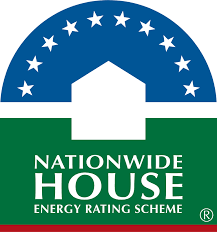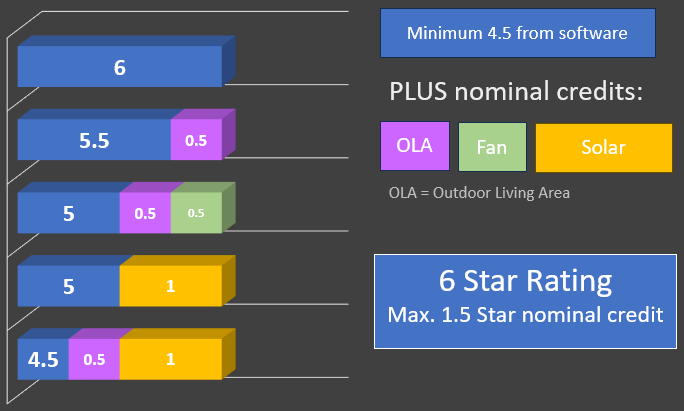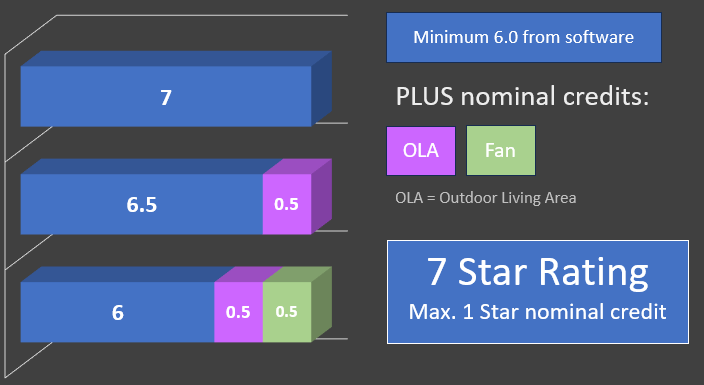Designing for 7 stars
A short primer for architects, designers and owners
on how to meet the new requirements.

7 Stars for New Homes
From May 1, 2024, many Australian States are set to adopt the new National Construction Code (NCC) 2022 Energy Efficiency requirements for Residential Buildings. This is a major change to Energy Efficiency requirements in many regions.
It will be a significant transition for the construction and design industry. Achieving 7 Stars will require more collaboration between Designers, Architects, Builders, Owners and Energy Efficiency Assessors.
To help the collobration we’re sharing a short primer on some of the factors to keep in mind when designing for 7 Stars.
The key changes:
7 Stars will be required for most homes - a jump of 1.0 - 2.0 stars in some areas
- Using NatHERS software, apartment buildings must now achieve minimum 6.0 Stars (up from 4.0 in some states), with the whole apartment building needing to achieve an average of 7.0 Stars (up from 5.0 or 6.0).
- Houses have a similar jump to 7.0 Stars, which in many cases is an effective jump of 1.5 Stars due to nominal credit changes (see below).
- Achieving an extra star requires an exponential increase in thermal fabric – so a 1.0 Star increase is a big deal.
New ‘Whole of Home’ requirements
- This new requirement in NCC 2022 will assess a household’s overall expected electricity usage by assessing the efficiency of proposed major appliances such as hot water and air con. This will be in addition to the current DTS/NatHERS building fabric assessment.
- This is where PV systems (solar panels) will now be assessed, and having solar panels will ease the other Whole of Home requirements.
No nominal credit for solar PV Systems in NatHERS
- Prior to the changes, a Class 1 design in Queensland would gain a 1.0 Star nominal credit (using NatHERS) for having a PV system. That is being removed, making it more challenging to achieve the 7.0 Star Rating.
- PV Systems are still accounted for, but under the ‘Whole of Home’ provisions.
- The 1.0 Star nominal credit available for a qualifying outdoor living area with ceiling fan is still available in certain climate zones.
DTS assessments now use NCC 2022 provisions
- As NCC 2022 housing provisions are adopted, Deemed to Satisfy assessments will need to use the NCC 2022 provisions, instead of (in Qld) the BCA 2009/2010 provisions or NCC 2019.
- NCC 2022 DTS requirements are much tighter than BCA 2009/2010 – we expect there will be less buildings complying using DTS, and more assessments using the alternative NatHERS method.
Get the Presentation on Designing for 7 Stars
We recently presented a seminar on ‘Designing for 7 Stars’ at the Design Matters National Brisbane event.
It’s got lots of helpful guidance and tips for designers and asssessors on making the transition to 7 stars. Download it here:

What are the changes to NatHERS ratings?
These charts show the change in NatHERS rating requirements for Class 1 buildings. The change in “Nominal Credits” that can be used means that the change is bigger than just the 1 Star jump from 6.0 to 7.0 Stars. Here’s what it looks like in Queensland:
Under the previous legislation
There were previously a number of “Nominal Credits”, which could be used for gaining 0.5 or 1.0 Star. These included ceiling fans, a qualifying outdoor living area and solar panels. Some combinations of multiple credits were allowed – as shown in the chart.
This meant that a NatHERS software rating of as little as 4.5 Stars could be sufficient for a building to comply, if it took advantage of all of those credits.

Under the new legislation
Solar is no longer available as a nominal credit (it is instead being included in the separate ‘Whole of Home’ assessment). Ceiling fans and qualifying outdoor living areas still provide a 0.5 credit each
The maximum available nominal credit is now 1.0.
This means that a building must now achieve a minimum 6.0 stars in the NatHERS software rating in order to acheive the required 7.0 stars overall.
For some buildings, this is an effective jump of 1.5 stars for the NatHERS software rating.

Designing for 7 Stars – A Primer
There are a range of design factors that Architects and Designers can work with to make 7 Star energy efficiency compliance more achievable for their clients. Here are our ‘top tips’.
Orientation
Case studies by Sustainability Victoria show that the costs of achieving 7 Stars can be more than double for a house with a poor orientation – it’s definitely worth considering!
Building design can seek to maximise sunlight in winter for natural warming, and shading in summer for natural cooling.
Orientation doesn’t just mean the direction of the footprint – it includes consideration of where to put glazing, doors and other elements.
Glazing
There are two main parameters that define glazing’s thermal performance:
- SHGC (Solar Heat Gain Coefficient) – measures how much heat enters the building via direct sunlight. The higher the number the more heat will enter the dwelling from direct sunlight – a high number good in winter, not so good in summer.
- U-Value – measures how much the glazing resists heat flow (irrespective of sunlight). The lower the number the more efficient the glazing.
SHGC and U-Value for glazing are important because glazing is often the biggest “heat leaker” in a house. We see glazing as a fixed barrier, but for heat, a closed window is the easiest part of the wall to get through.
Glazing dimensions, shading and specifications – and their impact on the look and feel of the overall design – are going to be a big part of 7 Star design considerations.
Insulation
This one might seem self-evident, but insulation can (obviously!) make a big difference to the thermal performance of a home. However, insulation often ends up being added to plans as an afterthought.
Some designs may need to consider 90mm stud walls in place of 70mm. Calculations for thermal bridging are now included in NCC 2022 requirements, so steel frame walls will also likely require a thermal break.
It’s also worth keeping an eye out for insulation in unexpected places – insulation under exposed floors can make a significant improvement to the whole building’s performance.
Designers will need to incorporate Energy Efficiency factors into their design earlier. Getting professional Energy Efficiency input early in a project may save a lot of headaches down the track.
Ventilation
Natural air in a building is pleasant; we like it, and often people prefer it to air conditioning. So if a building is well ventilated, the occupants are less likely to turn on air conditioning. You can include ventilation in your design in a number of ways:
- Windows – generally the more openable a window is the better the ventilation will be. You might consider whether to use louvre windows (90% opening) instead of sliding/double hung windows (45% opening), especially where fall from height restrictions would limit the opening of other window types.
- Roof cavity – it doesn’t make a huge difference, but ventilating the roof cavity in a hot climate can sometimes get you over the 7 Star line.
- Ceiling Fans – make a big difference. They need to be noted on plans, including their diameter.
Thermal Mass
North facing concrete slabs collect heat in winter, and indirectly warm the whole house/apartment. NatHERS software includes this in its calculations and it can help the performance of the whole building. The same is true for thermal mass walls.
Your thermal assessor can quantify how much difference the thermal mass can make by running models with and without it.
Include an Outdoor Living Area
The Queensland code allows a 1 Star nominal credit for any home that has a qualifying outdoor living areas with a ceiling fan. When it’s warm, many people will sit in the outdoor area with the fan on rather than go inside and turn on the air conditioning, and the legislation (very sensibly) gives credit for that. It’s an easy 1 Star to gain if you’re in Queensland and can include it in your design.
Frequently Asked Questions
Does my home need to rate at 7 Stars?
From May 1 2024, many states and the ACT will require all new homes to achieve an average Energy Efficiency rating of 7 Stars. New NSW homes will also be required to achieve 7.0 stars (using BASIX) from October 2023. While it’s a big jump from previous requirements, it can be achieved. We can assist with guidance on how to get to 7 Stars without completely blowing the budget!
For the latest details on adoption dates, see the ABCB website for the relevant date for your state/territory.
How much extra will it cost to rate my home at 7 Stars?
For some designs we have assessed, the difference can be as little as a few hundred dollars for some extra insulation; for other designs, more expensive changes are required. Sustainability Victoria have completed a range of case studies on the extra costs for a home to reach 7 Stars with additional costs going up to $15,000. You can read the Sustainability Victoria report here: https://assets.sustainability.vic.gov.au/susvic/7-star-upgrade-analysis.pdf. At BERA, we understand the desire to reduce the additional cost burden while still achieving a compliant home. We will work with you to help you understand where best to make modificatons, and how to achieve 7 Star compliance.
Still got questions?
Get in touch – we’re here to help!
